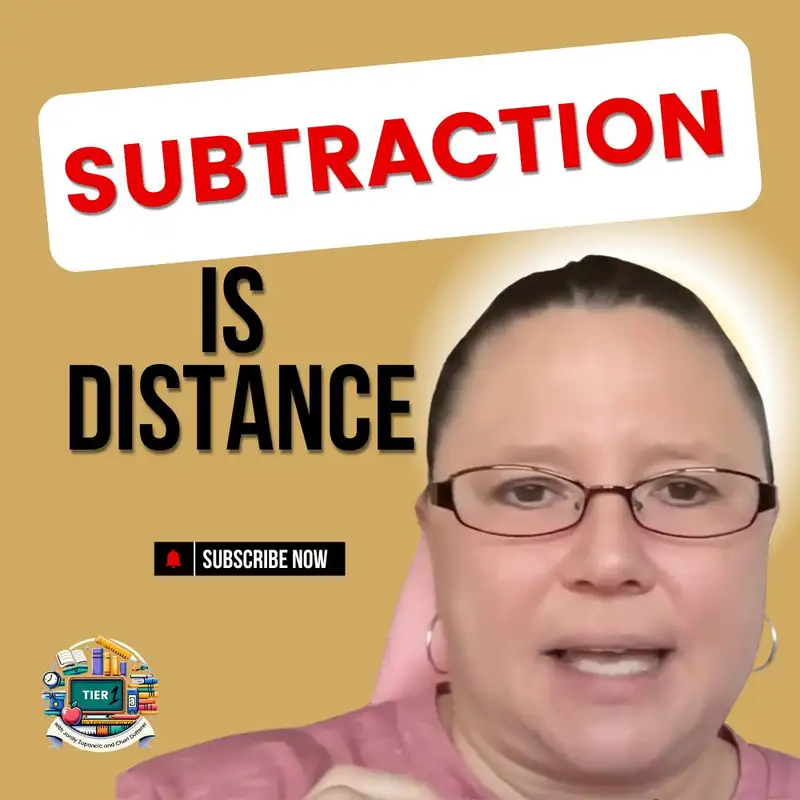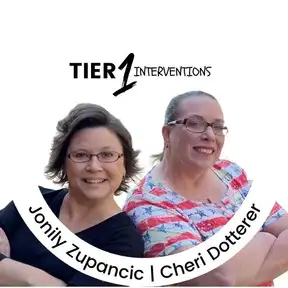
Teaching Additve Inverse to Promote Retention: S2 E7
[00:00:00]
Jonily: Jay Z here, Jay Z in the house! Jonily Zupancic here,
Speaker 5: hey everybody, it's Cheri Dotterer. You are here at Tier 1 Interventions where we are looking at activities that you can do for the entire classroom and teach all kids at the same time. Bye. We can also expand these activities that we're teaching to small groups and one on one sessions. So for you, occupational therapists that might be listening to this podcast, you might hear a lot of math, but you're also going to hear some of the non academic connections to what is going on with math,
Jonily, welcome to the podcast today. Tell us a little bit about responsive teaching
Jonily: I did Professional Development for one of the buildings and the discussion from before was customizing their instruction based on customizing their The Connection of [00:01:00] Reference Tasks and Standards.
One of the seventh grade math standards is subtraction of negative numbers. The standard says that kids need to understand that subtraction of negative numbers.
is the additive inverse. For example, there's an addition problem with the same answer as that subtraction problem.
One of the big themes yesterday was, how do we take these rich tasks, these reference tasks that kids are seeing multiple times a year, one of them is an intervention specialist, and she said, , I can't do reference tasks because my kids are so far below 7th grade level.
And I said. But the reference tasks are the same in first grade, and she didn't realize that. She's wait a minute. How are they the same in first grade when they connect to seventh grade standards? The [00:02:00] reference task is a much wider option of instruction,
the content is taught through the reference tasks. . not to the reference task. If I'm talking about subtracting negative numbers, I'm teaching to that, not through it. I'm using some kind of conceptual contextual experience as the vehicle for instruction, and then I'm going to teach to the standard.
The other misconception was, I'm not going to teach through the standard. For example, if I have the subtraction problem, 7 minus 3. There's an addition problem that gives you the same answer. 7 minus 3 is 4. There is an equivalent addition problem. This is for every subtraction problem that you ever create.
There's an [00:03:00] equivalent addition problem that gives you the same exact answer as 7 minus 3. And that is 7 plus negative 3. Now, there's actually lots of addition problems that give you the same answer, but if I'm going to use the same digits, then I can transfer subtraction to addition. And , this becomes a concept of equivalence.
Not additive inverse. , the biggest mistake we're making when we teach our math standards is teaching the standard. Let me explain this. We are trying to use the standard as our instruction And not our outcome. One of the teachers said to me yesterday, yeah, but the standard says that kids have to understand that every subtraction problem is an additive inverse problem.
Yes, that's the outcome. That's not our instruction. So the question we need to ask as facilitators is, [00:04:00] How do I get kids to understand the standard? We're going about this all wrong. How do I get kids to understand that every subtraction problem has an equivalent addition problem that gives the same exact answer?
If you never want to do subtraction in your entire life, You can make every subtraction problem an addition problem. The issue is kids make the addition problem wrong because they're explicitly taught a sing song. Just add the opposite. It's the same thing as flip and multiply.
When kids get to eighth grade, they're flipping the first one. They're not changing the division and multiplication, and then they keep the division, they flip the first, The procedures are a wreck. And what we're frustrated with as teachers is these kids don't remember. They don't [00:05:00] remember. We do not want kids to remember the math standard. We want kids to remember the core experience in which they discovered A phenomenon in mathematics that they can repetitively do independently over and over by engaging in that experience again.
I've not only described the math standards, but I've described the actual point of a reference task. The reference task is the core experience. It's the memory maker. It's the core memory. Because kids have, another Disney reference, Inside Out 2 has just been released, when I talk to kids in the classroom, I talked a lot about cognitive science and how their brain learns and how it doesn't learn.
And then we talked about how all of their brains are different. Even in October, I will bring back to them [00:06:00] metacognition. Tell me about what you were thinking when I asked that and when I said that. I said to my teachers yesterday, Look. You can say to your kids, every subtraction problem has an equivalent addition problem.
It's called the additive inverse. Here's what you do. You keep the first number, you change to addition, and then you change, the second number the opposite. You can tell them that as many times as you want. I'm not saying don't tell them. But the mindset shift is You can't expect they're going to remember it.
Just because you tell them, that doesn't mean they're going to remember it. Some will, some won't. The big question for my teachers was, then how do we get them to remember it?
Let me tell you what I told them, this is the outcome, not the instruction. Here's the instruction. Let me show you the instruction. [00:07:00] 7 minus 3. All subtraction is distance. The subtraction symbol is the number line. I'm going to put My arrows on the number line. That is essentially how subtraction is defined.
We can define it as takeaway also. Takeaway is not as transferable. To all subtraction problems, conceptually, but distance is. Now, we also, we want to expose kids to takeaway. We don't want to not say that it's not takeaway. Distance is much more conceptual. We know kids cannot do money, cannot tell time, and cannot measure with a ruler.
We know this. I'm not telling you anything new. If you're listening to this recording, if you're listening to any of this out there in public, We know, nobody will argue this, [00:08:00] kids don't know time, money, and measurement. So why not teach our standards, and teach operation, addition, subtraction, multiplication, division, square root, exponent.
Why not teach all of those procedural, we think are procedural things, conceptually. So that it works with any numbers. With 7 minus 3, I have 7 things and I'm going to take away 3, okay, yeah, what if I have 7 minus negative 3, do you see how we're teaching something in the moment, but we're not thinking, we're not spanning the big picture?
That's another thing reference tasks do. Reference tasks think ahead of you. If you expose kids to reference tasks, like pizza problem, Jesse and Kay, Quick Dots. Paint problem, 120 chart, making rectangles. If kids are exposed to those experiences and they're actively engaged in doing the mathematics and constructing the mathematics and figuring out the [00:09:00] mathematics, if they're actively engaged, not only will core memories increase, retention of content will increase, their connections will increase, but because those reference tasks are so conceptual and contextual.
Anytime kids see math notation, no matter what the notation is, they're going to refer to the reference task to help them solve it. And it's transferable. I keep saying that, but what transferable means is it applies to any situation in any number and any procedure and any notation. We want to teach instruction and have kids create, or have kids engage in experiences that are transferable.
That work for every pattern, every problem, every symbol, every everything. I'm just going to be real snarky for a minute. I've watched teachers teach simplifying square root of 12. What factors of 12 are perfect squares? It's 4 times 3. Oh, the square root of 4 is 2. We know this. But they're [00:10:00] teaching this as a jailbreak.
That has no math transfer, transformation, transferable ness at all. It's cute, I don't want to talk about people breaking out of jail in my math class, but that's just me. I'm not you. I can't tell you what to do, but they want you to change this to 12, this 12 to 4 times 3, and then 4 comes out of the radical, but 4 comes out as a 2, because 4 is 2 times 2, and you can only break out of jail in pairs.
First of all, there's no freaking rule that says you break out of jail in pairs. Why are we talking about breaking out of jail? You guys! I am in classrooms and this is what I'm watching as far as instruction in some places. Come on we gotta be better than that. I'm getting real aggressive here right now.
Don't be afraid, don't hang up on me, okay? Don't hang up, stay with me for a minute. The point is, we need [00:11:00] contextual situations that actually make sense to kids, and make sense mathematically, and are transferable to any number, symbol, and operation. We're looking at the distance.
Subtraction is distance and range. I start with the second number three. I go to a number line. I put the number three. , kids aren't going to like that. They want zero in the middle. Fine. Fine. You want zero in the middle? I'll put zero in the middle. Fine. If that is your habit, the only reason kids want zero in the middle is because they're Teachers, prior to them, always put zero in the middle, or on the left,
you guys, kids are learning this because of instruction, we're asking them to remember more, and then they are remembering, and then we're habitually training them to put zero in the middle or on the left of a number line. We're doing this to them! I'm fired up today, guys. I'm sorry. I'm not sorry.
If you want zero in the middle, fine. Then they have to figure out where to [00:12:00] put three. Actually, that's probably a good exercise to make them put zero in the middle, we're not making a good precise number line. , I have to start at three somewhere,
, because this is distance, I need to go to 7. I start at positive 3 and I go to positive 7. Here's my number line . I go to 7. It's good we have 0 if kids insist on this, and we write both of these, okay, then I have an opportunity to do responsive teaching. Because I'm gonna say, , you've got three and seven.
It didn't matter where I put three and seven because. But where I placed the third number on a number line is relative to where I placed the initial two. If I come back over here and kids are so insistent that they wanted to do this, I said, okay, I have to [00:13:00] say, all right, When you place the 7, first of all, they need to know it's to the right of 3, so if that's not, there's a different instruction that we do.
But when you place the 7, should the 7 be further from 3 than what the 0 is, or should it be? This is a great question for first grade. Through this experience, through kids actually grappling with this, through kids engaging in this, through kids swimming in the dirty bath water, they start to improve their sense of number.
Not by me telling them anything, but by me asking them the right responsive question. For example, when I play seven, Is it going to be further from the three than zero or closer to the three than zero? Now, if I want to ask that question a little less specific, I would [00:14:00] start my question with a how does, how do.
How do the numbers 3, 7, and 0 compare. , I've differentiated for the whole class. If we keep going, subtraction is distance, we start with the second number, we go to the first number, the 7 is here, I want to know the distance from 3 to 7. Starting at 3, going to 7, the distance is 4. And I move to the right, so the answer is positive 4.
This is transferable, remember the teachers were like, Okay, but How do I get them from here to here? , A, you can just tell them, every subtraction problem is addition, here's how you change it. Do they remember that? No. This is why 8th grade and high school teachers are like, these kids have no idea how to subtract integers.
But we told [00:15:00] them like 5 times, like 25 times, we told them, we showed them, they did worksheets on it. But you talk to it, not through it. You have to teach through the conceptual contextual experience. Now, this is not a reference task. Like our Dirty Dozen, but subtraction is distance is one of our conceptual checklist pieces.
Subtraction is distance. Technically it's another reference task, but it's a conceptual experience. Just like a reference task. Now, what does this have to do with anything? Kids know 7 minus 3. I need to get them to know that 7 minus 3 is the same thing as 7 plus negative 3.
First of all, we have to do a lot of swimming with distance. Now we need to do negative 7 minus 3. Here's our number line, the [00:16:00] subtraction symbol. Now, here's what we were talking about yesterday, too. We have Negative seven minus three. Seventh grade teachers will tell me, here's what I tell my kids.
I just tell them, that's a negative three. No, it's not. No, it's not, guys. The way this is written right now, that is a positive three. See, you're telling them false information. Yeah, but they know what I mean. It's just a negative three because there's that subtraction. No, you're giving them the misconception.
Right now, if I make subtraction my number line, this is a positive three on a number line, and I'm going to go to negative seven. I'm going to start at positive three, and I'm going to go to negative seven.
First of all, I'm going in the left direction, so my answer here is going to be negative because I'm going to the left direction. Now I have to find the [00:17:00] distance. Maybe I don't know the distance from three. Oh, but guess what? We can use that zero that you're so adamant we have to use all the time. The distance from three to zero is three.
And then the distance from 0 to negative 7 is 7. The distance is 10. So negative 7 minus 3 equals negative 10, because the distance from positive 3 to negative 7 is 10, and we went left. The negative means we went left. The answer to this is negative 10. We have to swim in subtraction for a long time, and then here's what I told the teachers.
After about 4 or 5 interactions with this, With spaced repetition, meaning we have to do something else for two or three days that's not subtraction, then come back to subtraction. Then what we do is we make a worksheet. We make a worksheet that's a two column worksheet. Here's my piece of paper.
[00:18:00] Here's my worksheet. I have two columns. Problem number one is negative seven minus three. Problem number two is four minus negative ten. Problem number three is negative three minus negative nine. You do eight subtraction problems on the left, and then over here you do problem number nine. Guess what?
Problem number 1 was negative 7 minus 3, so problem number 9 is going to be negative 7 plus negative 3. Don't tell kids , I want them to just see that this is going to be just a separate random problem, but it has to be in the second column across from this one. Problem number 10 is 4 plus 10.
Problem number 11 See, 3 was negative 3 minus negative 9. Problem number 11 is going to be negative 3 plus 9. , you make 16 problems. 8 on the left, 8 on the right. [00:19:00] I know that the right hand column is the additive inverse of the left. But I'm not going to tell kids this. I'm going to say to them, , do your distance problems on the left first.
Do all your distance problems, get an answer. Do all your problems on the right. Now get your calculator out, and check all your work. Type in every problem and check to see if you got the correct. So I don't have to check it. They're going to do it without a calculator first.
Then they're going to check it with a calculator. Then I'm going to say, , look at all the problems on the sheets and all of what you now know are the correct answers. What question am I going to ask? What do you notice? What do you see? And tell me about the results. Now, they're, with one interaction, they're not going to create a deep learning.
What I told the teachers yesterday was, make four other worksheets like this. Those are fairly easy to do, don't [00:20:00] give them four days in a row. Every two weeks, give one of the worksheets randomly out of the blue. In cognitive science, this is called interleaving. Interleaving means we give a repetition after space has gone by, so that kids have to try to retrieve retrieval practice, and then they're going to forget and re remember.
We celebrate forgetting because forgetting is necessary. Then the act of re remembering is going to deepen that neuropathway in the brain. Do these worksheets every two weeks. By the end of that time, the power of this instruction is going to lead much more to retention of that additive inverse standard than just saying, here's the standard, Every subtraction is keep change, and now let's do a bunch of [00:21:00] worksheets on it.
Let's just practice a lot. Let's practice a lot. That practicing in the moment is all for naught, because they just learned it, and yeah, they can repeat on autopilot. From when they just learned it. But then, if we are out of our unit on integers, which you guys know how I feel about a unit on, there shouldn't be a unit on integers.
It should be sporadic throughout the year. , it should be a part of every math season. There are five math seasons.
Without an integer unit, and I bring in integers every two weeks, negative numbers, every two, something every two weeks. Through that process, the spaced repetition process. The remembering and retention of the content. is exponentially greater. Now, I went off on this way crazy thing, but I'm coming off of such a high [00:22:00] yesterday, because when I went into that PD, I was not even going to talk about integers.
I went into that PD talking about how do we connect deep concepts to day instruction, but you see the connection there. The second thing I wanted them to walk away with yesterday was How do we ask questions and prompts and engage kids and experiences that create deep thinking? And the third takeaway I wanted them to have, because I prepared these three goals before I went in, the third takeaway that I wanted them to have was, I can't even remember.
I have it written here. No, I don't. I don't have it with me. I don't even remember the third one, but it was something related. Oh, I know. How reference tasks help make connections and associations. But when I went in, they had all these questions for me from our last experience, and one of them had to do with [00:23:00] negative numbers.
I was able to meet those three goals. Through the content that they requested, through their perspective, I actually did the greatest responsive teaching. If we are going to teach in a responsive teaching model, the number one thing we have to do is know our content deeply. And not just our standards, but how to instruct to our standards.
Speaker 2: That'll give you the inspiration this week,
natalie, what was your take away today?
Natalie: My gosh, I don't know if I have just one.
It's okay.
One of my classes, over half the classes operating out of third grade or below level, whether they're on an IEP or not. The other day I had to take a break from ratios because we were [00:24:00] really struggling.
I did purple X and the engagement just went. Because everyone can access that in some way. Yeah, all of that. I don't know if that makes sense, but a lot. Oh,
Speaker 2: perfect. Perfect sense.
That's what Jesse and Kay are. We'll get it on there. We will talk about it next month. You guys have a great month, and look forward to seeing you at Saturday Math and Impact Wednesday before next month. Yep. Talk to you later.
Speaker 6: Bye
Microphone Array (Intelr Smart Sound Technology for Digital Microphones) & ACER FHD User Facing: You too, could be part of the live audience, come and join us at tier one interventions workshops. Look for the link in the show notes.
Episode Video
Creators and Guests


